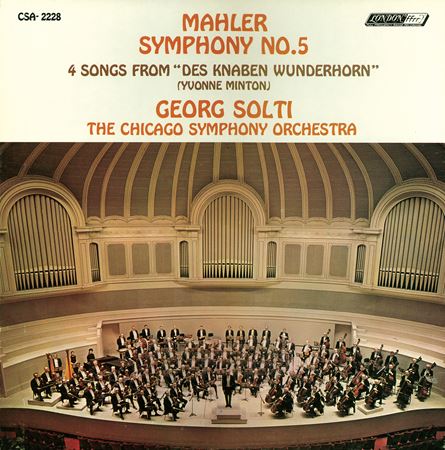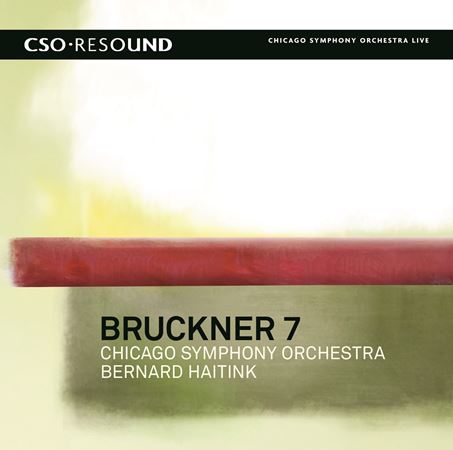David Sanders joined the CSO’s cello section in 1974.
© Todd Rosenberg Photography
The Chicago Symphony Orchestra’s commercial recording legacy began on May 1, 1916, when second music director Frederick Stock led the Wedding March from Mendelssohn’s A Midsummer Night’s Dream for the Columbia Graphophone Company. The Orchestra has since amassed an extraordinary, award-winning discography on a number of labels—including Angel, CBS, Deutsche Grammophon, Erato, London/Decca, RCA, Sony, Teldec, Victor, and others—continuing with releases on the in-house label CSO Resound under tenth music director Riccardo Muti. For My Favorite CSO, we asked members of the Chicago Symphony family for their favorite recordings (and a few honorable mentions) from the Orchestra’s discography.
Appointed to the Chicago Symphony Orchestra in 1974 by Sir Georg Solti at the age of twenty-four, David Sanders began playing cello at the age of twelve and started lessons at fourteen in Miami, Florida He made his solo debut eighteen months later with the Miami Symphonic Society Orchestra. Sanders has held principal cello positions with the Northwestern University symphony and chamber orchestras, the Civic Orchestra of Chicago, Lake Forest Symphony, and Florida Symphony. He also has played with the Lyric Opera of Chicago Orchestra, Grant Park Symphony Orchestra, and Milwaukee Symphony.
BRAHMS Concerto for Violin in D Major, Op. 77
Recorded in Orchestra Hall in 1955 for RCA
Fritz Reiner conductor
Jascha Heifetz violin
“Growing up in Miami, Florida, we didn’t have a lot of classical music recordings, even though my mother had studied piano as a young girl. Not knowing anything about Chicago or the Chicago Symphony Orchestra, we probably didn’t have any CSO recordings. I started studying the piano when I was about eight or ten, because that’s what you did back in the 1950s. Probably in my early teens, my parents joined the Columbia Records Club which came with a limited selection of recordings, including a few classical. My mother took me to the Miami Symphony Orchestra concerts, which had a series of (only) nine concerts throughout the year. I started playing the cello in junior high school at twelve and, still basically a beginner, began taking lessons at fourteen. My teacher had been from Chicago and had studied with Frank Miller during World War II, when he was at Great Lakes Naval Station. It was through her that I began to learn about Miller and the Chicago Symphony Orchestra. I remember that in high school I had somehow “discovered” Jascha Heifetz and fell in love with his recording of Brahms’s Violin Concerto with Fritz Reiner and the CSO. The violin playing was astounding, of course, and the orchestra playing was fantastic. The oboe solo, played by Ray Still, whose wind classes I would audit at Northwestern and who I later was lucky enough to call a colleague, was nothing short of spellbinding. One of my friends in high school was an oboe student, and she introduced me to a lot more of Ray’s playing through CSO recordings.”
MARTIN Concerto for Seven Wind Instruments, Timpani, Percussion, and String Orchestra
Recorded in Orchestra Hall in 1966 for RCA
Jean Martinon conductor
Donald Peck flute
Ray Still oboe
Clark Brody clarinet
Willard Elliot bassoon
Dale Clevenger horn
Adolph Herseth trumpet
Jay Friedman trombone
Donald Koss timpani
RIMSKY-KORSAKOV Sheherazade, Op. 35
Recorded in Orchestra Hall in 1960 for RCA
Fritz Reiner conductor
Sidney Harth violin
“While at Northwestern University, a number of my friends were wind and brass players whose teachers were Chicago Symphony Orchestra members. We would often listen to CSO recordings over and over, to hear how these wonderful musicians would turn a phrase and how the conductors would structure the music. In those years, probably the two recordings I listened to the most were Rimsky-Korsakov’s Sheherazade conducted by Fritz Reiner and recorded in 1960, and Frank Martin’s Concerto for Seven Wind Instruments, Timpani, Percussion, and String Orchestra conducted by Jean Martinon and recorded in 1966. The playing in both of these was breathtaking, and the record jacket informed us that the last movement of Sheherazade had been recorded in one take. The beauty of Frank Miller’s cello solos, Sidney Harth’s violin solos, and Ray Still’s oboe solos to this day still bring chills to my spine. The playing of the concerto soloists in the Martin, including a newly appointed Dale Clevenger, was awe inspiring.”
MAHLER Symphony No. 5
Recorded in Medinah Temple in 1970 for London
Georg Solti conductor
“I was thrilled to joined the CSO in June 1974, during the Ravinia Festival season, which was at that time eight weeks long. During the seventh week, a number of the cellists in the section started getting the music for Mahler’s Fifth Symphony from the library. We were going to be playing it during our September 1974 European tour, and even though they had played it many times and recorded it, they were already starting to practice it. I had bought the recordings of Georg Solti conducting the CSO in Mahler’s Fifth and Sixth symphonies when they came out in 1970, and I loved the overwhelming power and excitement of the performances. The ovations for the performances of the Fifth at Carnegie Hall had become legendary, and I was thrilled that I was going to be a part of those performances going forward. But I didn’t really know the piece, so I got the music and started practicing and also began listening to Solti’s recording again. It was a difficult piece for me to learn for the first time, and even trying to play along with the recording, I wasn’t getting as far as I wanted. I asked our long-time assistant principal cello Leonard Chausow some questions about it, and he was very helpful. The week following the CSO residency at Ravinia, there was a week of ballet performances that I had been hired to play; Lenny was the principal cello for that week, and I was his assistant. Before every rehearsal and concert, I brought in the music to the Mahler and he spent every day basically teaching me the piece, showing me what to look for, explaining the timing of the major cello passages, and everything else he could think of. He was a godsend, and I will never forget his kindness to me.”
BRUCKNER Symphony No. 7 in E Major
Recorded in Orchestra Hall in 2007 for CSO Resound
Bernard Haitink conductor
“Moving into the twenty-first century, one of the best recordings we have made and that I have enjoyed listening to is Bruckner’s Seventh Symphony with Bernard Haitink, our principal conductor from 2006 until 2010. The second recording on the CSO Resound label as well as the second release with Hatink, it is a wonderfully flowing recording and I think the playing of the Orchestra is superb.”
A few honorable mentions:
- MUSSORGSKY Pictures at an Exhibition with Rafael Kubelík for Mercury (1951)
- BRAHMS Symphony No. 2 in D Major, Op. 73 with Rafael Kubelík for Mercury (1952)
- STRAUSS Also sprach Zarathustra, Op. 30 with Fritz Reiner for RCA (1954)
- STRAUSS Ein Heldenleben, Op. 40 with Fritz Reiner for RCA (1954)
- BARTÓK Concerto for Orchestra with Fritz Reiner for RCA (1955)
- SMETANA Overture to The Bartered Bride with Fritz Reiner for RCA (1955)
- MENDELSSOHN Fingal’s Cave Overture with Fritz Reiner for RCA (1956)
- BRAHMS Symphony No. 3 in F Major, Op. 90 with Fritz Reiner for RCA (1957)
- MUSSORGSKY Pictures at an Exhibition with Fritz Reiner for RCA (1957)
- TCHAIKOVSKY Violin Concerto in D Major, Op. 35 with Jascha Heifetz and Fritz Reiner for RCA (1957)
- BARTÓK Music for Strings, Percussion, and Celesta with Fritz Reiner for RCA (1958)
- SCHUBERT Symphony No. 8 in B Minor, D. 759 (Unfinished) with Fritz Reiner for RCA (1960)
- BEETHOVEN Symphony No. 9 in D Minor, Op. 125 with Fritz Reiner for RCA (1961)
- RAVEL Suite No. 2 from Daphnis and Chloe with Jean Martinon for RCA (1964)
- BERLIOZ Symphonie fantastique, Op. 14 with Sir Georg Solti for London (1972)
Sanders adds, “During my forty-six years as a member of the Chicago Symphony Orchestra’s cello section, I have been privileged to make numerous recordings with this great orchestra. Among my favorites, and ones that I have listened to often, are:”
- MAHLER Symphony No. 1 in D Major with Sir Georg Solti for London (1983)
- MAHLER Symphony No. 2 in C Minor (Resurrection) with Sir Georg Solti for London (1980)
- MAHLER Symphony No. 3 in D Minor with Sir Georg Solti for London (1982-83)
- MAHLER Symphony No. 4 in G Major with Sir Georg Solti for London (1983)
- MAHLER Symphony No. 9 in D Major with Sir Georg Solti for London (1982)
- WAGNER Overtures from The Flying Dutchman, Tannhäuser, and Die Meistersinger von Nürnberg, and the Prelude and Liebestod from Tristan and Isolde with Sir Georg Solti for Decca (video) (1976)
- BRUCKNER Symphony No. 7 in E Major with Sir Georg Solti for Decca (video) (1978)
- MENDELSSOHN Symphony No. 3 in A Minor, Op. 56 with Sir Georg Solti for Decca (video) (1979)
- MENDELSSOHN Symphony No. 3 in A Minor, Op. 56 with Sir Georg Solti for London (1985)
- MAHLER Symphony No. 9 in D Major with Carlo Maria Giulini for Deutsche Grammophon (1976)
- BRUCKNER Symphony No. 9 in D Minor (Unfinished) with Carlo Maria Giulini for Deutsche Grammophon (1976)
- SCHUMANN Konzertstück for Four Horns in F Major, Op. 86 with Daniel Barenboim for Deutsche Grammophon (1977)
- SHOSTAKOVICH Symphonies nos. 1 and 7 (Leningrad) with Leonard Bernstein for Deutsche Grammophon (1988)
- MAHLER Symphony No. 1 in D Major with Klaus Tennstedt for EMI (video) (1990)
- MAHLER Symphony No. 2 in C Minor (Resurrection) with Bernard Haitink for CSO Resound (2007)
- MAHLER Symphony No. 3 in D Minor with Bernard Haitink for CSO Resound (2006)
- VERDI Messa da Requiem with Riccardo Muti for CSO Resound (2009)
MFC-006








